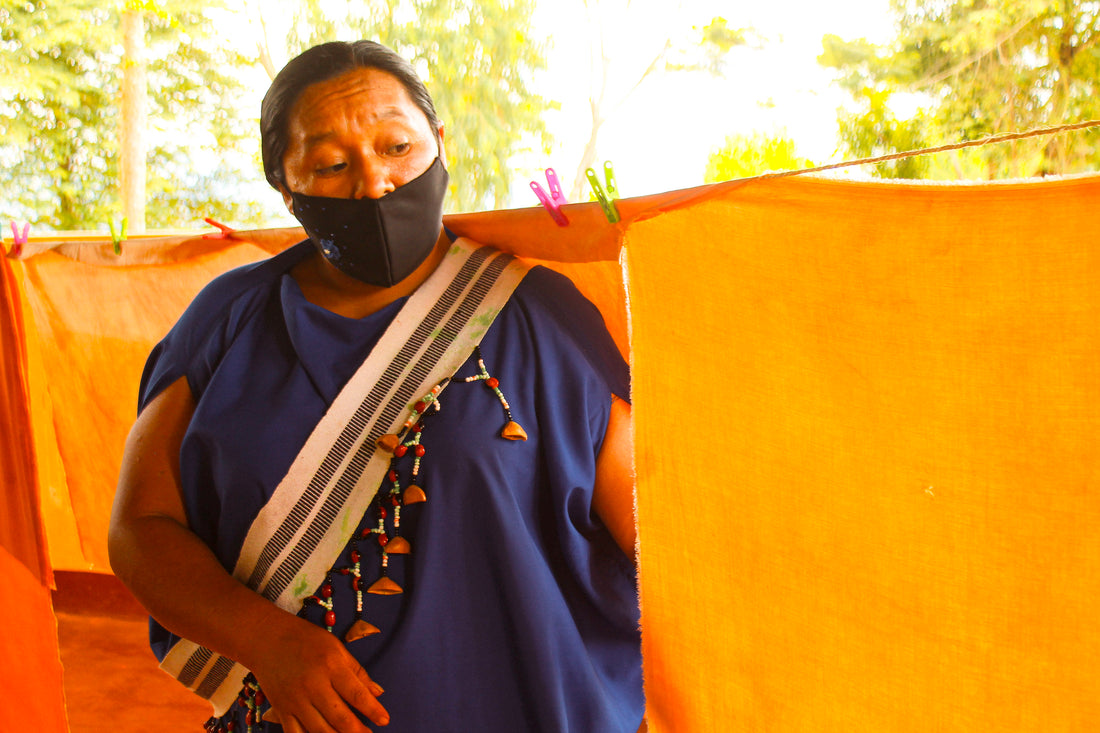
Vegetable Dyeing: An ancestral knowledge obscured by fast fashion but resilient for our communities.
Share

By Milagros Davalos Flores
Thanks to globalization, fast fashion has taken hold in society, imposing a style of clothing that is seductive for people but harmful to the planet. This has caused us to lose the tradition of dyeing our fabrics with plant dyes, since it is a job that requires patience and going at the pace of nature, but with fast fashion it is not like that, everything is immediate, and you can find all the colors you want throughout the year, satisfying the needs of the immediate client, which led us to stop working with nature, leaving aside this tradition, but thanks to some communities that have been resilient over time with this ancestral activity, we can give ourselves an opportunity to help the planet.
What problems do synthetic dyes cause to the planet?

According to reports, the textile industry is the second largest pollutant after oil , it is responsible for 20% of water pollution and 10% of greenhouse gases . This brings serious problems to the agricultural sector, since water is the main source for this sector, which harms us as consumers, generating an impact on our health.
It also harms those who handle these toxic substances; by not wearing adequate safety clothing when working with them, they inhale these toxic substances, which are harmful to their health.
These are some toxic substances used by fast fashion: Arylamides, formaldehyde, dimethyl fulmarate, phthalates, heavy metals such as nickel, chromium, cadmium, lead, mercury, chlorinated paraffins, all of these can cause cancer, respiratory problems, liver problems and dermatitis . Remember that it not only harms the one who manipulates it, but the entire population, since this generates an impact on the food chain of every living being, by contaminating the water of rivers, seas and lakes, the soil and air. One of the places where this activity is carried out most forcefully is Bangladesh, located in India, whose river is affected, presenting different colors due to the dumping of water mixed with dyes, of this you can have more information in the documentary " River blue ", where it shows us the impact that fast fashion generates at an environmental, social and cultural level.
A look at ancestral knowledge as a solution

Vegetable dyeing is an ancient activity that has been carried out in Latin America, the Caribbean and Asia, using roots, branches, leaves, and flowers.
According to Antonio Brack, a Peruvian scientist who studied the biodiversity of our country, in his book “ Encyclopedic Dictionary of Useful Plants of Peru”, he tells us that Peru is one of the countries that enjoys a wide biodiversity, many ecosystems, and a flora that has approximately 25,000 species, of which 134 species are used as dye plants; therefore in Peru we have a wide variety of species to experiment with and that little by little the varieties of colors that we can obtain from this wonderful ancestral technique will be investigated and exposed, in this way we contribute to ensure that this species is not forgotten, that it is valued by society and that it can generate extra economic income for the communities, and thus improve the conditions of their family.

Meanwhile, Killa has been working together with the Yanesha Wamprat Artisan Association of Lomalinda in Palcazú, Pasco , to extract natural dyes from various plants such as yetsniol, matico, tabaquillo, eucalyptus, turmeric, mango, payón, among others. These are ground and boiled, resulting in various colors. Likewise, fixatives are used so that the color remains on the fabric, such as copper sulfate and iron sulfate, among others.

For all these reasons, it is a great option to use vegetable dyes, since it will not generate toxic substances into the environment, which are harmful to the health of all living beings; we also rescue species, giving them added value for the textile industry, generating extra income for the communities and improving their quality of life, but above all we value our ethnic identity .

Magical colors extracted from nature

A study has shown that the origin and use of natural dyes and colorants have a magical connotation, as they are gifts from their divinities and they attributed supernatural powers to them to win wars, cure illnesses, obtain game in hunts or ensure a peaceful supernatural life, highlighting achiote ( Bixa Orellana ) which gives rise to the red color and huito ( Genipa americana ) the black color , as the most sacred and used, followed by turmeric or guisador ( Curcuma longa ) responsible for the yellow color.
Other colours tested at Killa are the pink colour obtained from avocado seeds, a caramel brown colour from walnut leaves, a golden colour from onion peels, and an intense orange colour from the bark of the payón tree, among others.

Nature never ceases to amaze me, every time I discover wonders that we can obtain from it, and it teaches me to return to it, to connect with its wisdom, so it is up to us as consumers to be the heroes of achieving these changes , with responsible and conscious purchases to avoid further damage to the planet, and will you join this fashion of natural intelligence?


1 comment
Nuestra madre tierra nos brinda todas sus bondades,plantas tintóreas que usadas desde tiempos milenarios por nuestras comunidades nos regalan la magia del color que debemos admirar y valorar.